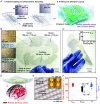Flexible electronic/optoelectronic microsystems with scalable designs for chronic biointegration
- PMID: 31308234
- PMCID: PMC6681732
- DOI: 10.1073/pnas.1907697116
Flexible electronic/optoelectronic microsystems with scalable designs for chronic biointegration
Abstract
Flexible biocompatible electronic systems that leverage key materials and manufacturing techniques associated with the consumer electronics industry have potential for broad applications in biomedicine and biological research. This study reports scalable approaches to technologies of this type, where thin microscale device components integrate onto flexible polymer substrates in interconnected arrays to provide multimodal, high performance operational capabilities as intimately coupled biointerfaces. Specificially, the material options and engineering schemes summarized here serve as foundations for diverse, heterogeneously integrated systems. Scaled examples incorporate >32,000 silicon microdie and inorganic microscale light-emitting diodes derived from wafer sources distributed at variable pitch spacings and fill factors across large areas on polymer films, at full organ-scale dimensions such as human brain, over ∼150 cm2 In vitro studies and accelerated testing in simulated biofluids, together with theoretical simulations of underlying processes, yield quantitative insights into the key materials aspects. The results suggest an ability of these systems to operate in a biologically safe, stable fashion with projected lifetimes of several decades without leakage currents or reductions in performance. The versatility of these combined concepts suggests applicability to many classes of biointegrated semiconductor devices.
Keywords: bioelectronics; biomedical implants; electrocorticography; flexible electronics; heterogeneous integration.
Conflict of interest statement
The authors declare no conflict of interest.
Figures





Similar articles
-
Conductively coupled flexible silicon electronic systems for chronic neural electrophysiology.Proc Natl Acad Sci U S A. 2018 Oct 9;115(41):E9542-E9549. doi: 10.1073/pnas.1813187115. Epub 2018 Sep 18. Proc Natl Acad Sci U S A. 2018. PMID: 30228119 Free PMC article.
-
Ultrathin, transferred layers of thermally grown silicon dioxide as biofluid barriers for biointegrated flexible electronic systems.Proc Natl Acad Sci U S A. 2016 Oct 18;113(42):11682-11687. doi: 10.1073/pnas.1605269113. Proc Natl Acad Sci U S A. 2016. PMID: 27791052 Free PMC article.
-
Materials and processing approaches for foundry-compatible transient electronics.Proc Natl Acad Sci U S A. 2017 Jul 11;114(28):E5522-E5529. doi: 10.1073/pnas.1707849114. Epub 2017 Jun 26. Proc Natl Acad Sci U S A. 2017. PMID: 28652373 Free PMC article.
-
Skin-Inspired Electronics: An Emerging Paradigm.Acc Chem Res. 2018 May 15;51(5):1033-1045. doi: 10.1021/acs.accounts.8b00015. Epub 2018 Apr 25. Acc Chem Res. 2018. PMID: 29693379 Review.
-
Recent Advances on Thermal Management of Flexible Inorganic Electronics.Micromachines (Basel). 2020 Apr 9;11(4):390. doi: 10.3390/mi11040390. Micromachines (Basel). 2020. PMID: 32283609 Free PMC article. Review.
Cited by
-
Technology Roadmap for Flexible Sensors.ACS Nano. 2023 Mar 28;17(6):5211-5295. doi: 10.1021/acsnano.2c12606. Epub 2023 Mar 9. ACS Nano. 2023. PMID: 36892156 Free PMC article. Review.
-
Transient charge-driven 3D conformal printing via pulsed-plasma impingement.Proc Natl Acad Sci U S A. 2024 May 28;121(22):e2402135121. doi: 10.1073/pnas.2402135121. Epub 2024 May 21. Proc Natl Acad Sci U S A. 2024. PMID: 38771869 Free PMC article.
-
A biomaterial-silicon junction for photodetection.Mater Today Bio. 2023 Apr 24;20:100642. doi: 10.1016/j.mtbio.2023.100642. eCollection 2023 Jun. Mater Today Bio. 2023. PMID: 37153757 Free PMC article.
-
Tracking neural activity from the same cells during the entire adult life of mice.Nat Neurosci. 2023 Apr;26(4):696-710. doi: 10.1038/s41593-023-01267-x. Epub 2023 Feb 20. Nat Neurosci. 2023. PMID: 36804648
-
Shape-changing electrode array for minimally invasive large-scale intracranial brain activity mapping.Nat Commun. 2024 Jan 24;15(1):715. doi: 10.1038/s41467-024-44805-2. Nat Commun. 2024. PMID: 38267440 Free PMC article.
References
-
- Won S. M., et al. , Recent advances in materials, devices, and systems for neural interfaces. Adv. Mater. 30, 1800534 (2018). - PubMed
Publication types
LinkOut - more resources
Full Text Sources
Other Literature Sources

